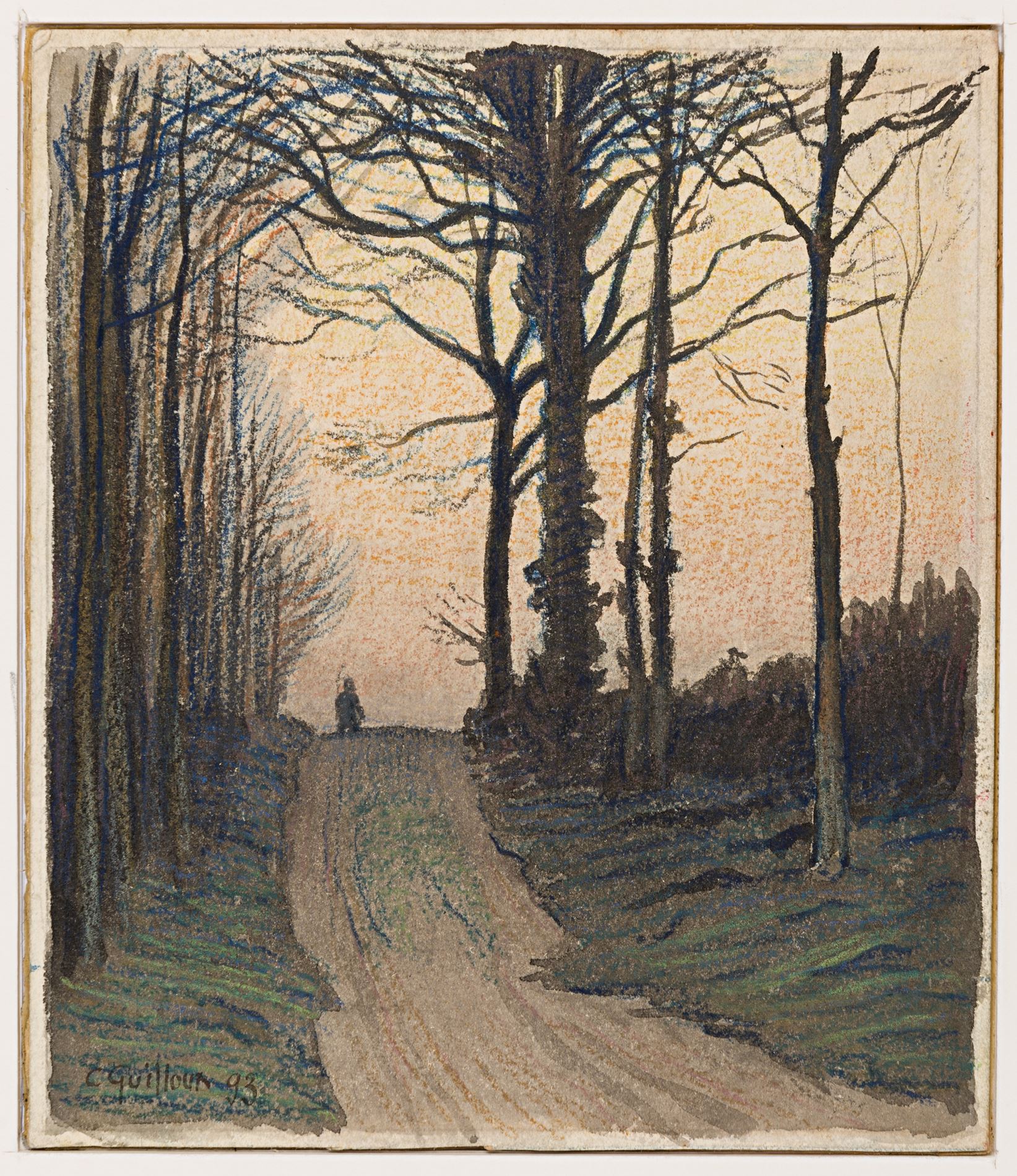Charles GUILLOUX
(Paris 1866 - Lormes 1946)
Autumn Landscape with a Figure on a Path
Sold
Black chalk, pastel and watercolour, with traces of a framing line in pencil.
Signed and dated C. Guilloux 93 at the lower left.
145 x 125 mm. (5 3/4 x 4 7/8 in.)
Signed and dated C. Guilloux 93 at the lower left.
145 x 125 mm. (5 3/4 x 4 7/8 in.)
Charles Guilloux’s works on paper are characterized by the same atmospheric effects and somewhat elegiac quality of his paintings, as well as a confident handling of pencil, watercolour and pastel, sometimes using all three at once, as in the present sheet. Dated 1893, at the beginning of the artist’s independent career, this fine autumn landscape evinces an air of mystery and melancholy that is a recurring feature of Guilloux’s distinctive oeuvre.
Self-taught as an artist and relatively unknown today, Charles-Victor Guilloux worked briefly at the Bibliothèque Nationale in Paris before devoting himself to his chosen profession. He first exhibited his landscape paintings at the Salon de la Société des Artistes Indépendants in 1892, where all eight of his works were sold, and one review of the exhibition noted that ‘M. Charles Guilloux possesses a personal vision, a refined understanding of nature, from which much can be expected.’ He was soon associated with the Symbolist movement, taking part in several of the exhibitions of Peintres Impressionistes et Symbolistes at the Galerie Le Barc de Boutteville, alongside Paul Gauguin and the Nabis artists. (A reviewer of one of the Le Barc de Boutteville exhibitions in 1892 praised Guilloux’s contribution as ‘A magnificent series of landscapes sent in by an unknown who is a master’.) Solo exhibitions of his work were held at Le Barc de Boutteville in 1896 and 1898.
Guilloux mainly painted views of Paris and its surroundings, as well as the landscapes along the banks of the Seine – near the villages of Herblay and Frette-sur-Seine, close to his home - and also in Brittany. He often depicted landscapes at twilight with misty, atmospheric effects. Although Guilloux made studies sur le motif, he preferred to work on his visionary landscapes in his studio, leading the noted art critic Roger Marx to describe him as ‘an artist who is more concerned with poetry than exact reality.’ Like the Nabis painters, his work also evokes an interest in Japonisme and Synthetism. In later years Guilloux exhibited at both the Salon de la Société nationale des Beaux-Arts and the Salon des Indépendants, while a group of eight Parisian views was included in the fourth exhibition of the Société des Peintres du Paris Moderne at the Grand Palais in 1907 and a one-man exhibition was held at the Galerie Hessèle in Paris in 1912. Guilloux also produced a number of colour lithographs, one of which, entitled The Deluge, was commissioned in 1893 by the publisher André Marty for the seminal print portfolio L’Estampe originale and is probably his best-known work today.
Paintings by Charles Guilloux are today in the Musée d’Orsay in Paris, as well as in the museums of Beauvais, Meudon, Montpellier, Moulins and Vic-sur-Seille. Among the few drawings by the artist in a public collection outside of France is a Breton landscape in watercolour and pastel, dated 1896, in the Cleveland Museum of Art.
Guilloux mainly painted views of Paris and its surroundings, as well as the landscapes along the banks of the Seine – near the villages of Herblay and Frette-sur-Seine, close to his home - and also in Brittany. He often depicted landscapes at twilight with misty, atmospheric effects. Although Guilloux made studies sur le motif, he preferred to work on his visionary landscapes in his studio, leading the noted art critic Roger Marx to describe him as ‘an artist who is more concerned with poetry than exact reality.’ Like the Nabis painters, his work also evokes an interest in Japonisme and Synthetism. In later years Guilloux exhibited at both the Salon de la Société nationale des Beaux-Arts and the Salon des Indépendants, while a group of eight Parisian views was included in the fourth exhibition of the Société des Peintres du Paris Moderne at the Grand Palais in 1907 and a one-man exhibition was held at the Galerie Hessèle in Paris in 1912. Guilloux also produced a number of colour lithographs, one of which, entitled The Deluge, was commissioned in 1893 by the publisher André Marty for the seminal print portfolio L’Estampe originale and is probably his best-known work today.
Paintings by Charles Guilloux are today in the Musée d’Orsay in Paris, as well as in the museums of Beauvais, Meudon, Montpellier, Moulins and Vic-sur-Seille. Among the few drawings by the artist in a public collection outside of France is a Breton landscape in watercolour and pastel, dated 1896, in the Cleveland Museum of Art.





